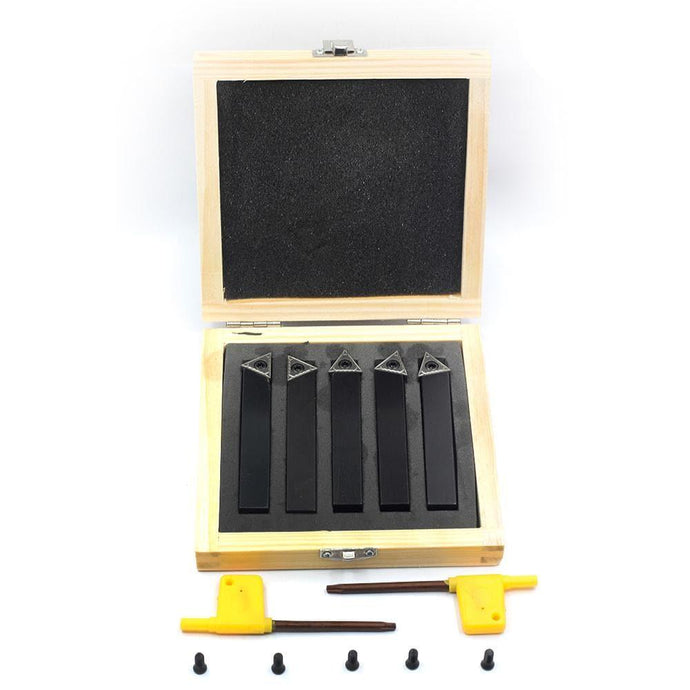Carbide Inserts for Hardened Steel: Unlocking Precision in Tough Machining
In the world of machining, hardened steel presents one of the toughest challenges. With its high tensile strength and resistance to wear, it's widely used in industries like automotive, aerospace, and heavy machinery where durability is key. However, these same qualities that make hardened steel ideal for manufacturing durable parts also make it incredibly difficult to machine. This is where carbide inserts come into play. Specifically designed to withstand the high forces and extreme conditions involved in machining hardened steel, carbide inserts have revolutionized the industry by allowing for efficient and precise operations on even the toughest materials.
Carbide inserts, made from tungsten carbide, are engineered to deliver exceptional hardness and wear resistance. Tungsten carbide is a compound that combines the strength of tungsten with the carbon atoms to create a material that can cut through hardened steel without losing its edge. This durability is essential when working with hardened steel, which would quickly wear down or even destroy tools made from softer materials like high-speed steel (HSS). Carbide inserts, on the other hand, maintain their sharpness for extended periods, even when machining hardened materials, reducing tool wear and ensuring a longer tool life.
One of the major advantages of using carbide inserts for hardened steel is their ability to handle high cutting speeds. Machining hardened steel generates a significant amount of heat due to the friction between the tool and the material. In many cases, excessive heat can cause traditional cutting tools to soften or lose their edge, leading to poor performance or tool failure. Carbide inserts, however, are capable of withstanding high temperatures without degrading, making them ideal for high-speed machining applications. Their heat resistance not only helps maintain tool integrity but also enhances the overall efficiency of the machining process. Higher cutting speeds result in faster cycle times, which in turn boosts productivity and reduces production costs.
Carbide inserts also offer unmatched precision when machining hardened steel. The cutting edges of these inserts are extremely sharp and retain their sharpness even under extreme conditions. This precision is critical in industries where tight tolerances and high surface finish quality are required. Whether it's for automotive engine components, aerospace parts, or industrial molds and dies, carbide inserts ensure that the machined surfaces meet the necessary specifications without compromising on quality. The ability to machine hardened steel with such accuracy is a key advantage in modern manufacturing, where precision is often non-negotiable.
Another important feature of carbide inserts is their resistance to wear. Hardened steel is not only tough, but it is also highly abrasive, which can cause rapid wear and tear on cutting tools. Carbide inserts, with their high wear resistance, can withstand the abrasive nature of hardened steel, allowing them to maintain their cutting performance over longer periods. This reduces the frequency of tool changes, minimizes downtime, and lowers overall tooling costs. In high-production environments, where efficiency and cost management are crucial, the longevity of carbide inserts provides a significant advantage.
Versatility is yet another reason carbide inserts are favored for machining hardened steel. These inserts are available in a variety of geometries, coatings, and grades to suit different machining applications. Whether for roughing operations, where large amounts of material need to be removed, or for finishing operations that require a high-quality surface finish, there's a carbide insert tailored to the specific demands of the job. Coatings such as titanium nitride (TiN), titanium carbonitride (TiCN), or aluminum oxide (Al2O3) are often applied to carbide inserts to further enhance their wear resistance and performance when cutting hardened steel. These coatings help reduce friction, dissipate heat, and protect the tool from chemical reactions that could degrade its performance.
The economic benefits of carbide inserts for hardened steel are clear. Although carbide inserts may initially cost more than traditional cutting tools, their longer lifespan, superior performance, and ability to operate at higher speeds make them more cost-effective in the long run. The reduced need for frequent tool changes, combined with the increased productivity from faster cutting speeds, translates into significant savings for manufacturers. Additionally, fewer tool replacements mean less downtime, which is especially important in industries where time is money and production schedules are tight.
In conclusion, carbide inserts have become an indispensable tool for machining hardened steel. Their unmatched hardness, heat resistance, and precision make them the go-to choice for industries that demand high performance and durability. Whether it's for producing critical components in the automotive or aerospace sectors or for creating molds and dies for industrial applications, carbide inserts deliver the reliability and efficiency needed to machine hardened steel with confidence. As manufacturing continues to evolve, carbide inserts will remain a key technology in overcoming the challenges posed by tough materials, ensuring that precision and productivity are never compromised.
